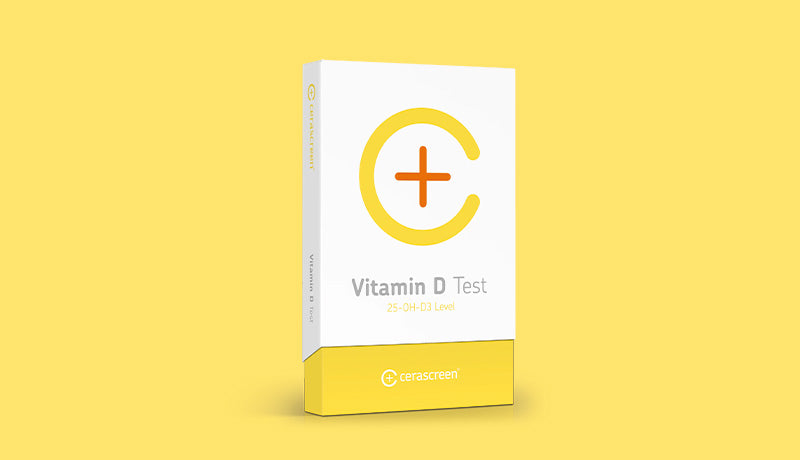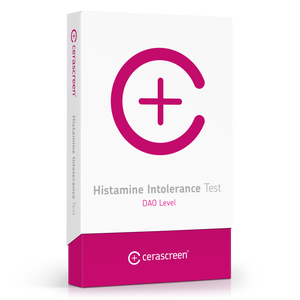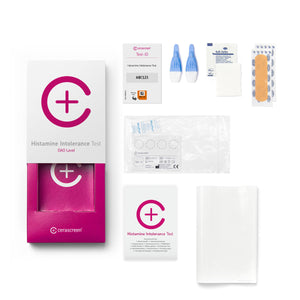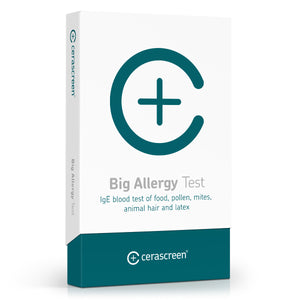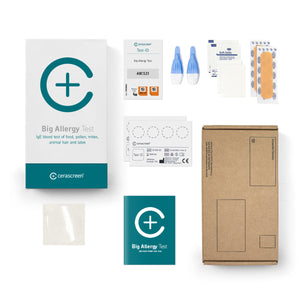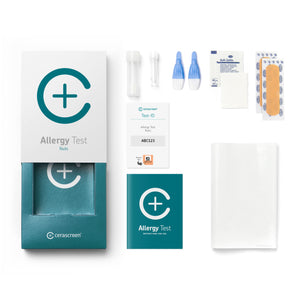product_id = 1690033094715variant_id = 15978410541115template_name =
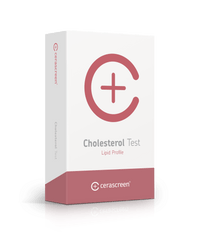
Cholesterol Test
Lipid Profile
About the test
The cerascreen® Cholesterol Test is a send-in health test kit that measures the relevant blood fat values if there is an increased risk of developing arteriosclerosis. The test determines the total cholesterol, HDL, LDL and triglyceride levels as well as the total cholesterol–HDL ratio.
Does your heart always pound heavily or does your blood pressure rise for no apparent reason? This might be caused by your cholesterol! Cholesterol is often mentioned as a risk factor for heart and cardiovascular disorders as well as strokes. But there are two types of cholesterol – LDL and HDL.
LDL is considered the ‘bad’ cholesterol because a high LDL level leads to a build-up of cholesterol in your arteries. Arteries constrict, and blood begins to clot. Over time, blood thickening and artery constriction combined make a heart attack or high blood pressure more likely.
HDL is called the ‘good’ cholesterol because it carries LDL cholesterol from other parts of your body back to your liver. Your liver then removes the LDL cholesterol from your body. This helps to keep the blood vessels clean. High HDL levels reduce the risk of heart disease, but low levels increase the risk.
Like cholesterol, triglycerides are a type of fat, or lipid, in your blood. Elevated triglyceride levels can raise your chance of vessel constriction and heart disease.
Cholesterol Test
- Take your sample at home – conveniently and discreetly
- Receive a state-of-the-art laboratory analysis
- Get an idea of your cholesterol levels
- Benefit from specific recommendations to improve your LDL cholesterol levels
- Receive your result within 5 to 7 working days after sample’s arrival in the laboratory
Benefits of the Cholesterol Test
Knowing your cholesterol levels can help you take thoughtful steps to improve the health of your blood vessels. High LDL cholesterol means an increased risk of cardiovascular diseases – but it is very manageable through lifestyle changes and by optimising your cholesterol levels.
With the cerascreen® Cholesterol Test you don’t have to visit a doctor’s surgery, and you don’t have to wait. With a small prick of the finger, you can take a few drops of blood at home and send in your sample. Experts in a medical laboratory will then evaluate the sample in vitro.
Benefit from our expertise: cerascreen® is the market leader for medical sampling and submission kits in Europe, with eight years of experience in test development and analysis. We have developed more than 50 approved send-in test kits (medical devices), evaluated 250,000 samples and serve 19 countries.

Result of the Cholesterol Test
As soon as your sample has been analysed, you will receive your results report via the My cerascreen® app or your user account on our website. You can easily view the report on your smartphone, tablet or computer and print it out, if required.
Find out if your cholesterol and triglyceride levels are within the green range, learn how you can change your LDL cholesterol by changing your lifestyle and read about what blood lipids are and how they are related to arteriosclerosis.
Frequently asked questions about Cholesterol Test
Why take the Cholesterol Test?
Bad cholesterol levels are a known risk factor for cardiovascular disease. If there is too much ‘bad’ LDL cholesterol in your blood, it contributes to the fact that the blood vessels become calcified. This in turn increases the risk of cardiovascular diseases such as heart attacks and strokes.
The World Health Organization estimates that every second person in high-income countries has high cholesterol levels. Many of those affected are not aware of this; high cholesterol does not usually present with noticeable symptoms.
However, you can influence your cholesterol: lifestyle and, above all, diet affect your cholesterol composition. It is recommended to check your cholesterol levels regularly.
Who should take the home cholesterol test?
Since the symptoms of high cholesterol are not often clearly visible, almost everyone can benefit from knowing their cholesterol evels.
Our Cholesterol Test is particularly useful for people who are at an increased risk of developing high LDL cholesterol. The at-risk groups include:
- The elderly and men
- Smokers
- People with high blood pressure
- People with type 2 diabetes
- People with a family history of heart attack and stroke
How does the Cholesterol Test work?
To do the Cholesterol Test, use a lancet to take a small sample of blood from your fingertip. Then send your sample to our CLIA-certified partner lab using the return envelope. The lab will test the concentration of various blood lipids (LDL and HDL cholesterol, triglycerides) in your capillary blood.
The test needs to be carried out on an empty stomach, so please don’t eat anything in the 12 hours prior to the test.
How long does the analysis take in the laboratory?
Once your sample has arrived at the laboratory, it will be analyzed there by specialists. How long the analysis takes depends on the exact measuring method and the processes in the laboratory.
If the sample is sent on the correct days (Sunday to Tuesday), this makes it easier for the laboratory to adhere to the times.
For the Cholesterol Test, the laboratory analysis is usually completed within 5 working days after the sample is received in the laboratory.
What does the results report tell me?
The Cholesterol Test will help you assess your risk of arteriosclerosis, along with other risk factors.
To do this the following values will be measured and presented in the results report:
- Total cholesterol in micromoles per litre of blood (mmol/l)
- HDL cholesterol in mmol/l
- LDL cholesterol in mmol/l
- LDL–HDL quotient – that is, the ratio of LDL to HDL cholesterol
- Triglycerides in mmol/l
If your level of LDL cholesterol is elevated (therefore increasing the LDL– HDL ratio), this means you have an increased risk of calcification of the blood vessels (arteriosclerosis). This calcification in turn increases your risk for cardiovascular diseases such as high blood pressure, stroke and heart attack.
Elevated triglyceride levels can also damage the heart and blood vessels, but can be reduced with a balanced diet.
What recommendations will I receive?
You might need to take action if your LDL cholesterol, the bad cholesterol, is above normal.
You will be given recommendations to help you lower your LDL cholesterol levels. Most of all, this is advice on diet and exercise.
If your test result indicates an increased risk of arteriosclerosis, please consult a doctor. They can help you assess your other risk factors and decide if treatment is necessary.
What is cholesterol?
Cholesterol is a fat-like substance that is packed into certain proteins in the body, either the HDL or the LDL protein. HDL cholesterol is considered the good cholesterol, and LDL cholesterol is considered the bad cholesterol.
Cholesterol is made in the liver, and your body uses it to make hormones such as vitamin D, cortisol and oestrogen, among other things. We can also get cholesterol through food. It is mainly found in animal fats such as butter, eggs, milk, cheese and meat. The more cholesterol we take in through food, the less the liver produces – that is why your cholesterol intake is not the only factor influencing your cholesterol levels.
What are the symptoms of high levels of bad cholesterol?
High LDL cholesterol levels is not noticeable with symptoms – this makes them difficult to detect without a test.
The bad cholesterol can, however, over time result in fatty buildup being deposited in the blood vessels. This calcification of the blood vessels (arteriosclerosis) increases the risk of cardiovascular diseases such as high blood pressure, stroke and heart attack.
What causes high levels of bad cholesterol?
Foods that are high in cholesterol are not the only contributor to bad cholesterol levels.
Instead, typically a combination of various lifestyle factors is to blame. Obesity, lack of exercise, diabetes, alcohol and cigarettes all play a role. Some people are also genetically predisposed to have high cholesterol levels.
How do I improve my cholesterol levels?
It’s not just foods that are high in cholesterol that lead to bad cholesterol levels. Your weight and exercise have the greatest influence. Weight loss, regular exercise and a balanced diet are the most important steps you can take to improve your cholesterol levels.
In addition, you can eat fewer foods that increase LDL cholesterol. These include crisps and sweets, highly processed meat, soy and sunflower oil and alcohol.
Who should NOT take the Cholesterol Test?
The test is not or only partially suitable for certain groups of people:
People with infectious diseases, like hepatitis and HIV, may not use the Cholesterol Test.
People with haemophilia should not take the test.
Pregnant and breastfeeding women should only take the Cholesterol Test under medical supervision. The given reference ranges and recommendations do not apply to people in this group; consult your medical professional for advice concerning your test results.
The Cholesterol Test is not intended for children under 18 years of age.
The test is not intended for diagnosing illnesses or disease. For example, if you suffer from depression or are in physical pain, consult a doctor.
Why are children under 18 not allowed to take the test?
Our tests are not suitable for underage children and adolescents under the age of 18. Under 18s cannot activate the tests online and therefore cannot receive a test result. We ask that you do not administer the tests to your children either.
Children and adolescents need much closer supervision and counselling regarding medical tests and their interpretation. Testing with lancets and chemicals is not without risk and would need to be closely supervised by guardians. In addition, the reference values we give are always based on adult data. In the case of children, the risk of misinterpreting the results would be very high.
We want to fulfil our responsibility as a provider of medical products and ensure that children and adolescents are not unsettled by measurement results that are difficult for them to interpret. Since we cannot control whether the minors' legal guardians actually consent to the test being carried out and supervise them, we exclude tests for under 18s altogether.
If you are under 18 and have purchased a test, please contact our customer support.
Why does it take up to a week for the sample to reach the lab?
Please bear in mind that your results will not be analyzed in the UK but in Germany. For that reason, it can take up to a week for the sample to arrive at the lab. This does not affect the stability of the samples, as the method we are using is optimized for long transports.
Initially, your sample is sent to our collection center in the UK. From there, it is shipped to our central sample sorting facility in Germany, which then distributes samples to our partner laboratories. Once your sample is analyzed there, you will receive a notification and can access your result online.
Please check your mailbox regularly. We will notify you as soon as your sample is sent, arrives, or is analyzed.
Why does the test have an expiration date?
The cerascreen® test kits are CE-marked medical devices, which in turn include other certified medical components such as lancets, patches, and alcohol swabs used in blood tests.
Like most medical devices, these components have an expiration date to ensure that they remain safe and effective. Many of our sample carriers – such as dried blood cards or sample tubes – are chemically treated to keep your sample stable and analyzable in our laboratory. Over time, environmental factors can affect this treatment and compromise accuracy.
Our sterile, single-use lancets also carry an expiration date to guarantee sterility and safe use up to that time.
This is how it works
1. Test at home
Your test kit contains everything you need to draw a small sample of blood from your fingertip. Then send the sample back to us free of charge in the enclosed return envelope.
2. View results online
After the evaluation in the medical specialist laboratory, you will have online access to your personal result report.
3. Act
Your access to the test results and the evidence-based findings and tips to improve your health: the my cerascreen® user profile on our website or our app.

